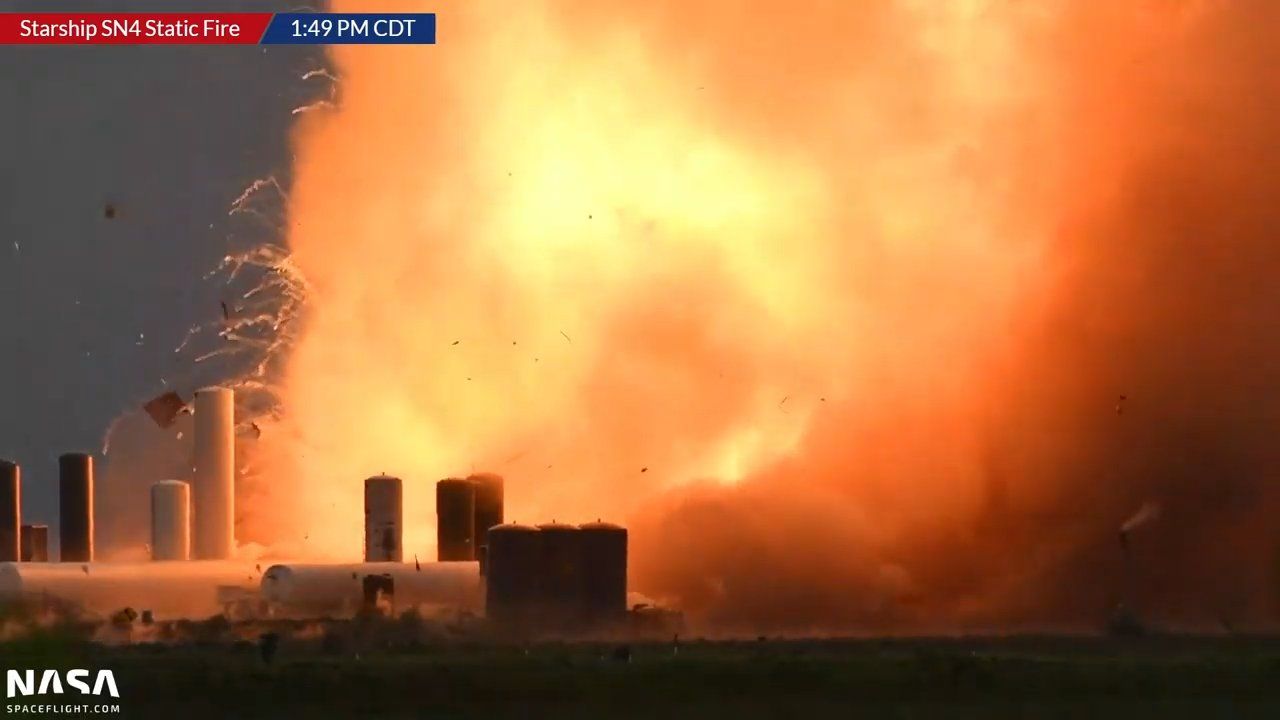
Screengrab from NASASpaceflight.com video
SpaceX’s Starship underwent a Rapid Unscheduled Disassembly—we do mean rapid
The accident came after what appeared to be a successful static fire test.
by Eric BergerOn Friday, SpaceX prepared its latest iteration of the Starship prototype vehicle, known as Serial No. 4, or SN4, for a static fire test in Texas. The Raptor engine appeared to fire nominally for a couple of seconds at 1:47pm local time and then shut down as planned.
However, about one minute after engine shutdown there was some kind of uncontrolled gaseous leak, and one minute later the vehicle exploded almost instantaneously—a truly rapid Rapid Unscheduled Disassembly.
The Starship prototype, fueled with liquid oxygen and methane, appeared to be mostly destroyed when the fire and smoke cleared. The test stand also sustained substantial damage. Some of the surrounding ground support equipment appeared unharmed, but it is possible the shock wave from SN4's demise may have also damaged those structures.
It was not immediately clear what happened—whether this was an issue with the ground support equipment or the vehicle itself. Until this incident, SpaceX appeared to be making good progress with its latest Starship prototype. A similar, successful static fire test had been performed on Thursday.
The company's first static fire tested SN4 on May 5 at its South Texas Launch Site. Since then, the company fired the rocket one more time with its original Raptor engine before swapping to a new engine. This was the third static fire test of the new engine. A full video of propellant loading, the static fire test, and destruction of SN4 is available on NASASpaceflight.com's video of the event.
Based on road closure schedules, it appeared as though SpaceX may have been testing in preparation for a short, 150-meter hop as soon as this coming Monday. On Thursday, the company received a launch license for multiple suborbital tests from the Federal Aviation Administration
SN4 was not the full configuration of Starship, as it lacked a nose cone, flaps, and other features needed for flight. However, it had the bulk of the vehicle, including its liquid methane and liquid oxygen tank structure. In addition, during the last week, SpaceX added what appeared to be a mass simulator on top of the prototype—perhaps in anticipation of forthcoming hops.
Despite its unfortunate demise, SpaceX engineers will have gleaned a lot of data from SN4 and its five static fire tests. Between November 2019 and April 2020, the company lost three full-scale Starship prototypes during cryogenic and pressure tests. SN4 was the first vehicle to survive pressure testing and move on the engine ignition
Although undesirable, these failures are a byproduct of an iterative design program that builds fast, tests, finds failures, and fixes them. The company has SN5 already waiting in the wings, as that prototype is nearing completion at SpaceX's rocket factory beneath tents in South Texas. Parts of SN6 are already being assembled, and local photographers have even spied components for SN7.
The limiting factor for the next round of tests could be the company's ability to construct a second test stand. Prior to Friday's accident, the company had already begun construction of a new one near the original Starship test stand.